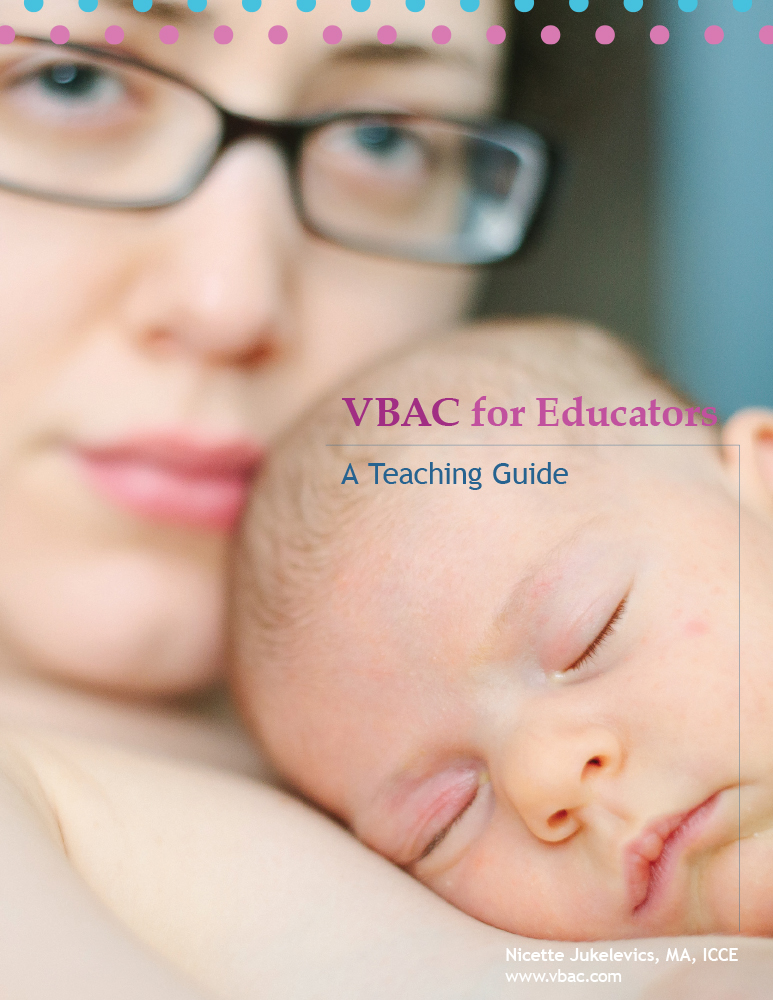By Jess Larsen Jukelevics, MA, CD(DONA)
VBAC families commonly come to birth with hopes or determination for a different experience, fear of repeating some part of their first birth, and sometimes unresolved feelings about giving birth again. In short, it can often feel (for every one) that the stakes are high.
We know that labor support is associated with better outcomes (Childbirth Connection, 2013), and a doula can go a long way to alleviate the fear and anxiety a VBAC mom may experience. But it’s also critical for doulas to be capable of supporting the emotional realities of VBAC women regardless of the clinical outcome of the VBAC attempt. 
So how can a doula:
- Offer help that best supports a family’s chances of a successful VBAC?
- Hold the space for a family no matter the outcome in a productive and healthy way?
In prenatal work together with the family:
Depending on how the family is approaching this birth, it may be helpful to plan for more time prenatally than you might with other families. Before now, they may not have had an opportunity to digest what happened last time, their feelings about it, or to get clear on what they want this time (particularly if their first child is still young). Their time with you may be the most productive and helpful time they’ve had to do that. If they need more help than you can offer, refer them to a Birth Story Medicine® session[1] or local birth trauma workshop. These can be very healing experiences for parents.
Survey the mom’s emotional landscape. Has she needed special support as part of her recovery from the last cesarean? Did she experience it as traumatic? Or was it an uncomplicated and easy decision for her the first time? (It is likely her experience lies somewhere in the middle of those extremes.) Expect some significant shifts in how she feels as her due date gets closer.
Be aware of her support landscape as well. Does she have the support of her partner, family, friends and community in her hopes for a VBAC? Does she feel like she has to fight for what she wants? If you approach her VBAC hopes as logical, normal, and positive, you may be setting an example for others, or offering support she’s not getting privately. Also remember that it’s not your responsibility to change anyone’s mind, but to support the needs and wishes of your client as best you can. Can you refer her to a local ICAN (International Cesarean Awareness Network) chapter or Facebook/Meetup group of VBAC moms?
How about her clinical support? This is a delicate conversation for a doula. A family chooses a caregiver for many reasons, some of which you will never know. It is also true that while some caregivers indicate that they will support a VBAC in theory, their track record says otherwise. If you have a sense from your own experience that this caregiver is not likely to support a VBAC, it may be worth a careful conversation about your past experiences with this clinician. Proceed with caution: a sense that you are second-guessing or not trusting the family’s decisions will not serve anyone.
Get the clinical and emotional facts. Ask: What happened clinically, to the best of their knowledge? (They may need to ask questions and clarify with caregivers and/or request their medical records to get a complete picture.) What happened emotionally for this family? What did that birth ask of them, and how does it linger?
Ask solution-focused questions to help them reflect and clarify what they want and need this time. For example:
- What did you learn from your cesarean birth that will help you give birth vaginally this time?
- What is it about a cesarean birth that you’re hoping to avoid this time?
- What will it mean about you as a woman or mom if you have a VBAC this time? What will it mean if you have another cesarean birth?
- Are there ways in which a VBAC could be a problem for you?
- Imagine yourself birthing your next baby with confidence and clarity. What do you need this time to do that?
Ask for the father’s/partner’s perspective. Perhaps no one has ever asked the partner what the last birth was like. What is the most powerful memory from that birth? What were the turning points in that birth? What does the partner need this time to be better able to support the expectant mother?
Use thoughtful language. Phrases like “failed VBACs,” “failed inductions,” and a woman who “was sectioned” can feel hurtful to a mother. Be conscious of the ways word choices promote a failure/success dichotomy or a passive role for the mother in her own birth.
Remind the family that outcome is not everything. We know that for mothers the factors most highly associated with satisfaction in childbirth are (1) having good support and a high-quality relationship with caregivers, and (2) being involved in making decisions about their care. Having everything go “according to plan” isn’t necessary or enough. In what ways is she eager to be involved in the decisions made about her care? How could she stay emotionally present for the birth of her next child, and what small things could she do, if a repeat cesarean is necessary?
If you were the doula for her first birth, welcome constructive feedback about your role at that birth. Initiate a conversation about how it went last time, what happened, and what she would like more or less of from you this time. What do they need you to do differently?
During labor:
Prepare yourself and the family for a potentially long labor. If the mother labored at least to the point of active labor the first time, after 6cm her second labor may go quickly. But if she didn’t labor at all the first time or reached a few centimeters before her cesarean birth, her labor is likely to progress like a first-time mom.
How can you support the family in letting labor begin and progress on its own? Share resources in this vein to help parents minimize their chances of an induced or augmented labor.
Use your knowledge of what happened last time to anticipate emotional and physiological benchmarks. It could be a certain point in dilation, in labor’s duration, or when something happened, (i.e. after her water broke, her baby turned posterior, or after she agreed to a particular intervention). To the mother (or her partner!) reaching those benchmarks may feel like a hurdle was overcome, or it could lead to intense flashbacks.
If the mother starts to have flashbacks, try helping her with focusing and breathing exercises that bring her back to the present moment. (Finding a rhythm with guided visualization, counting her breath patterns aloud, guided body scans, or shifting her attention to each of her senses one at a time may be helpful.)
If the mother finds it helpful, point out ways that this experience is already different from the last time. Notice aloud what you see, what you see her doing, and any small reminders that this is an entirely new and different birth. This practice may be helpful for anyone that was at her first birth: her partner or husband, any family members present, and even you!
Remember that you are not there to “save” this mother or her family from another cesarean birth. Her birth outcome is ultimately not within your control. The key: helping this family respond in the moment to what’s unfolding and what’s needed, and validating their ability to make the best choices for themselves.
If it starts to look like a repeat cesarean is going to happen, encourage the family to have all their questions answered. If time permits, help them try everything they can do. If the cesarean is not imminent give them a moment to digest what happened. This space and time, and the knowledge that they did everything in their power, may help them later.
In early postpartum work together with the family:
Don’t assume you know how the mother feels about her birth yet. Ask open-ended questions to give you a sense of how her experience is affecting her, and remember how quickly birth stories can change. (What was the most powerful moment of this birth for you? What is your strongest memory?) Even a hoped-for VBAC may bring up conflicted feelings. If possible, have information on hand for peer support groups in your area.
Supporting a family through a VBAC or a repeat cesarean can be among the most demanding, meaningful, and poignant experiences in a doula’s career. Likewise, the families you serve benefit greatly from your grounded presence. To that aim, please don’t overlook the nurturing and self-care that is required for you to come to each birth with curiosity, humility, and care. Your families deserve it, and so do you!
References
Childbirth Connection. (2013). Best evidence: Labor support. Retrieved from http://www.childbirthconnection.org/article.asp?ck=10174
[1] http://www.birthingfromwithin.com/pages/birth-story-medicine
This article was written for VBAC for Educators: A Teaching Guide





0 Comments